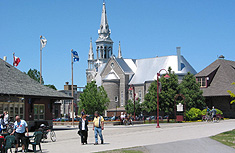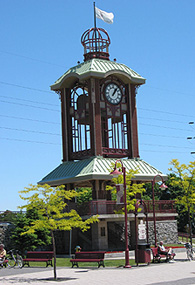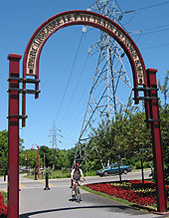 Located at the edge of the lower Laurentians on the picturesque Rivière du Nord, Saint-Jérôme is often called the “Capital of the Laurentians”. With a population of 60,000, including the surrounding sectors of Bellefeuille, Lafontaine, and Saint-Antoine, the town is an important regional administrative and service centre, with a strong retail and industrial base. The tourism industry is developing, as well, thanks in part to summer music festivals that attract thousands of visitors, and to the town’s position at the start of the “P’Tit Train du Nord” bicycle corridor along the former line of the CP railway. And of course, Saint-Jérôme’s historic downtown makes for a pleasant stop on any drive through the area.
Located at the edge of the lower Laurentians on the picturesque Rivière du Nord, Saint-Jérôme is often called the “Capital of the Laurentians”. With a population of 60,000, including the surrounding sectors of Bellefeuille, Lafontaine, and Saint-Antoine, the town is an important regional administrative and service centre, with a strong retail and industrial base. The tourism industry is developing, as well, thanks in part to summer music festivals that attract thousands of visitors, and to the town’s position at the start of the “P’Tit Train du Nord” bicycle corridor along the former line of the CP railway. And of course, Saint-Jérôme’s historic downtown makes for a pleasant stop on any drive through the area.
Founded in the 1830s by Irish, Scottish and French-Canadian Catholics, Saint-Jérôme was the region’s first major settlement. Development really only began to take off, however, after the arrival in 1868 of the celebrated Curé Antoine Labelle (1833-1891). It was Labelle who placed the parish of Saint-Jérôme at the forefront of his plans for developing the Laurentians. Among his achievements, Labelle brought the railway from Montreal to Saint-Jérôme in 1876. His dream was to colonize and open up the north to tourism with the help of the railway. In large part, he succeeded, and Saint-Jérôme played a key role.
A number of historic buildings have been carefully preserved in Saint-Jérôme, and make for an interesting tour of the downtown area. A convenient starting point is Parc Labelle, which is lined with trees and which contains a splendid bronze monument to Antoine Labelle. Erected in 1924, the monument is the work of renowned Quebec sculptor Alfred Laliberté. 
Across the street from the park is Saint-Jérôme Cathedral. A towering edifice, it was built at the end of the nineteenth century and features splendid stained glass by Delphis Beaulieu. The cathedral museum contains an exhibit on the life and work of Antoine. Entry is free. Surrounding the park are some fine Victorian homes. The Maison Bruno-Nantel, to the west, is the former home of a federal cabinet minister. It dates to 1884. To the south is the Maison Blanche, built in 1891. To the north is the magnificent former courthouse and prison. Built in the Beaux-Arts style in 1924, it is now the Maison de la culture du Vieux-Palais. a cultural centre featuring concerts, exhibitions, and a library.
A short walk from the park is the old station (1897) of the Canadian Pacific Railway. During the summer, the local historical society, la Société d’histoire de la Riviére du Nord, presents an exhibition on local history. Renovated in recent years, the station now serves as the starting point for cyclists traveling north on the “P’Tit Train du Nord” trail. It is a busy spot during the summer.
Other interesting sites in Saint-Jérôme include the town hall (280, rue Labelle), built in 1874 in the neo-classical and Georgian styles, and Saint-Jérôme’s first flour mill, dating to 1855 and located at 50, rue Saint-Faustin. A 0.6 km walk along the Rivière du Nord between the rue De Martigny bridge and the rue Saint-Joseph bridge offers some scenic views. A series of descriptive panels provide background on the history of Saint-Jérôme.
For more information on local sites, visitors may wish to procure the heritage tour published recently by the historical society and available at local outlets.
(Photos: Matthew Farfan)